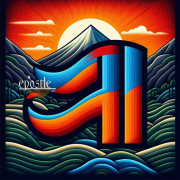Eternal Present
Armodoxy for Today: Eternal Present
At the top of most altar areas is the Armenian Church there is a solitary symbol that stands still amidst the paintings, icons, brass hardware and tall curtains vying for our attention. It the seventh letter of the Armenian alphabet “Է” and pronounced “eh” as the “e” in elevator. The symbol also finds its way into artwork, books and on khatchkars (carved cross stones), where it has also served as a secret code during times of persecution.
The letter “eh” is the verb to-be (is) in the present tense. In the Armenian Church it is the name of God. In Holy Scripture, Moses asks God, … When I come to the children of Israel and say to them, ‘The God of your fathers has sent me to you,’ and they say to me, ‘What is His name?’ what shall I say to them? And God said to Moses, I AM WHO I AM. And He said, Thus you shall say to the children of Israel, ‘I AM has sent me to you.’ (Exodus 3:13-15)
The name of God is “I am” and accordingly, “He is!” He is in the eternal present – not He was, or He will be, but forever, He is! Is it any wonder that Jesus uses the same words to present himself? I am the light of the world, I am the good shepherd, I am the way, the truth and the life… I am, He is, “eh” is the name of God which appears mystically in ornament and overt form.
When His Holiness Vazken I, of blessed memory, came to open the Armenian Martyrs’ Monument in Montebello in 1968, he brought with him a khatchkar which is placed as the centerpiece of the monument. It presents the “eh” boldly, becoming a mark of the First Christian Nation on Earth, in the public space in the secular world.
And it is not by chance that the “eh” – the eternally present “He is” – is the seventh letter of the Armenian alphabet! Mesrob Mashdots who invented the 36 letters of the Armenian alphabet strategically placed “eh” as the seventh letter as letter of completeness. Seven is the sum of four (the number of earth with four directions) and three (the number of heaven, the Holy Trinity). The seventh letter, “eh,” the name of God, is the ALL, completeness, heaven, and earth.
And there’s more… such as the year of Armenia’s conversion is the 301 which has two prime factors: 43 and 7. But we’ll save that for another day.
When we view life, and thus history, we view it in four dimensions – place and time. God’s view is outside of time and eternally in the present. God’s vantage point sees the Crucifixion and the Resurrection at the same moment. Jesus challenges us to live in the moment. His statements about the “Kingdom of God” are void of time reference. Furthermore, he cautions us not to live in the past and not to worry about tomorrow. The past is gone and cannot be changed or altered, hence his demand for us to forgive. (Matthew 18:21-22) The future, on the other hand, has no guarantees, as the parable of the “Rich Fool” (Luke 12:13f) graphically brought that reality to our attention. For us, the challenge is to live in the only accommodating space, namely the present. It is a difficult but worthy exercise.
For today, we think of God as eternal “I am” or “He is.”
Let us pray, O Lord, Jesus Christ, you taught us to pray, “Our Father who art in heaven, hallowed by thy name…” You presented Him to us as Father, surrounded by time, and as eternal Divinity, not bound by space or time. Help us to accept this Mystery and focus our energy on living in the moment – loving those around me, caring for those who hurt, extending comfort to those in need. Help me to keep my thoughts on sharing the love you have placed in my heart and sharing that love without restraint. Amen.



 2025 Fr Vazken
2025 Fr Vazken

 2015 Fr. Vazken
2015 Fr. Vazken
Leave a Reply
Want to join the discussion?Feel free to contribute!